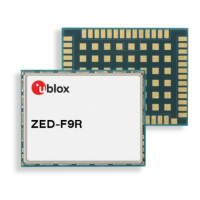ZED-F9R-Integration manual
• E-scooter
• Robotic lawn mower
3.2.2.1 Automotive dynamic model
The automotive dynamic model is used for applications with dynamics equivalent to those of a
passenger car. The automotive dynamic model shall be selected by the configuration item CFG-
NAVSPG-DYNMODEL = 04.
It combines the GNSS signal with the data from gyroscope, accelerometer and wheel ticks (or
speed measurements). More information can be found in the Solution type section. The automotive
dynamic model supports Degraded HPS mode, with missing wheel tick data. More information can
be found in the Degraded HPS mode section.
To reach centimeter-level accuracy, the ZED-F9R requires RTCM stream at all times.
The automotive dynamic model supports both the Automatic IMU-mount alignment and the User-
defined IMU-mount alignment.
For the automotive dynamic model, the position, velocity, heading, pitch and roll are frozen
when the vehicle is static. The static state is determined once the sensors are calibrated
and the wheel ticks are stationary.
3.2.2.2 E-scooter dynamic model
Supported from firmware version HPS 1.21 onwards
The e-scooter dynamic model is used for applications with dynamics equivalent to those of an
e-scooter. An e-scooter is a low-speed vehicle with one pulling non-steering rear wheel and one
steering front wheel. The e-scooter dynamic model shall be selected by the configuration item CFG-
NAVSPG-DYNMODEL = 12.
It combines the GNSS signal with the data from gyroscope, accelerometer and wheel ticks (or speed
measurements), more information can be found in the Solution type section. The e-scooter dynamic
model supports degraded HPS mode with missing wheel tick data. More information can be found
in the degraded HPS mode section.
To reach centimeter-level accuracy, the ZED-F9R requires RTCM stream at all times.
The e-scooter dynamic model only supports the User-defined IMU-mount alignment.
The e-scooter feature benefits from odometer measurements (wheel ticks or wheel speed) from
either wheel. Ideally, the odometer data should come from the rear wheel if the IMU is in the deck
and from the front wheel when the IMU is in the handlebar.
The receiver starts calibrating the sensors once the following conditions are met.
• Speed is over 2.5 m/s.
• Heading accuracy is under 6 deg.
• Roll rate is less than 20 deg./s.
• Pitch rate is less than 15 deg./s.
• Heading rate is less than 15 deg./s.
The positioning performance may be degraded when the e-scooter is driving on uneven
surfaces like cobblestone roads due to the increased noise of the IMU measurements.
The positioning performance is not guaranteed in special maneuvers where the e-scooter is
lifted and carried, flipped 180 degrees, or left lying on the ground and lifted up again.
UBX-20039643 - R06
3 Receiver functionality Page 21 of 119
C1-Public

